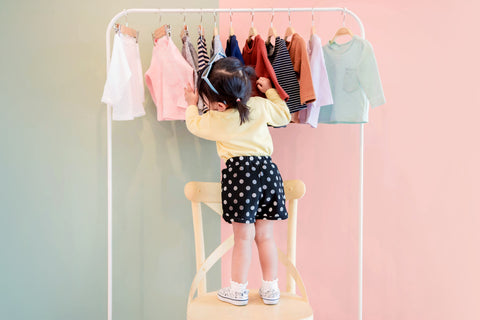Children and Their Clothes

One of the first signs of independence expressed by children is the desire to choose their own clothes. This can be a jarring transition for parents, used to dressing their kids as they see fit with little to no resistance. All of a sudden, your child may decide that they won’t wear the color red at all or that their entire outfit must be red, and the next day may bring a completely different set of rules—down to the number of buttons, the presence of pockets, or the existence of a zipper. Though you may not have anticipated a fashion war so young, thankfully there are strategies for successfully navigating children and their clothes.
Personal Expression
Most adults settle into a daily pattern of choosing their clothes without consciously thinking about making a personal statement. Kids, on the other hand, enjoy clothing on a different level, such that what they wear is often a direct expression of how they see themselves and/or who they want to be. Certain children may gravitate towards clothing with their favorite book or TV characters on the front, whereas others may want to dress like someone they admire such as a sports hero or dancer. Depending on the mood of each child, they may not be able to verbally express their thought process as far as what they prefer to wear.
No matter if their fashion choices are logical or inexplicable, children see their clothes as an extension of themselves. Therefore, clothing is much more about their personal expression than practicality or aesthetics. It may seem “immaterial” to parents as far as what their child wears, but the decision may be of great significance to the child in terms of showing the world who they are. Understanding this integration between clothing and personal expression is essential in raising kids to be confident in their identity and respectful of the diverse personal expression of others.
Though it can be difficult, try to avoid demonstrating or imposing any preconceived notions about what your child “should” be wearing in terms of their gender or other aspects of their identity or body type. This can be difficult, especially for parents who are inclined to see their child dress in more traditional styles or colors. Keep in mind that kids should have as much control over their appearance and personal expression as possible, within reasonable boundaries.
Avoid Clothing Conflict
One way that kids can assert their independence as well as feel that they have some agency over their choices is to decide what they do and do not want to wear. This can end up in some clothing conflicts, especially if dressing for school or a certain public occasion is involved that demands more formal attire. Even the weather can be a point of contention if a child decides to refuse to wear a coat in the cold.
The best way for parents to handle these clothing conflicts is to avoid them—but not simply by giving in. Ultimately, it’s important to encourage a child’s personal expression while also ensuring they understand societal dress codes when appropriate and necessary. Here are some clever ways for parents to compromise without undermining a child’s sense of independence and agency:
- At-Home and Going-Out Wardrobes: if your child has a sense of style that doesn’t quite fit with public outings, weather changes, or school dress codes, have them help you divide their clothes into an “at-home” wardrobe and “going-out” wardrobe. Then give them free reign of what they wear at home with the understanding that they will have to choose from their going-out wardrobe when not at home.
- Accessory Choice: if your child is unhappy about wearing certain clothing when necessary, allow them to choose one or two accessories, such as socks, a scarf, a bracelet, backpack, etc. Perhaps they can even choose an outfit for a doll or stuffed animal to bring along as a compromise.
- Fashion Consultant: give your child a chance to help you choose part of your outfit when you go out. Showing them that their opinion and/or suggestion is valued and important will have a reciprocal effect in how they interpret your opinions and/or suggestions.
- Choice of Two: present two full options of clothing for your child and let them independently choose which outfit to wear. Make sure to fully accept and approve their choice once it’s made to avoid any confusion or misgivings.
Enjoy the Looks
Perhaps the most important thing to remember when it comes to children and their clothes is to allow some fun. If you are concerned that your child’s outfit might generate some “looks” from others out in public, but you aren’t going anywhere that demands a certain dress code, take that as an opportunity to model your own self-confidence and acceptance of their personal expression. Truthfully, children outgrow their expressive stages—and clothes—very quickly. You may not fully appreciate their fashion choice of a superhero shirt or neon orange sweater to wear to the park, but the day may come sooner than you can imagine when you will miss these bold outfits. Therefore, it’s important to enjoy and support the way they look as long as possible.
One of the best ways to encourage healthy self-confidence and appreciation of diversity in children of all ages is to offer activities that foster mastery of different skills and intellectual stimulation. At Cognisprings, we support parents and their children with games, books, and puzzles that are thoughtfully designed, educational, and unique. Our products allow families to create memories of togetherness and enhance a child’s understanding of the world, including ways to reflect individual expression. We believe in providing options for screen-free fun, healthy personal and cognitive development, creativity, and exploration.
